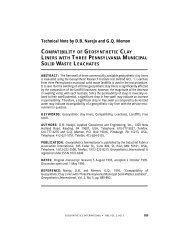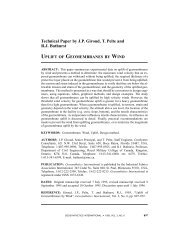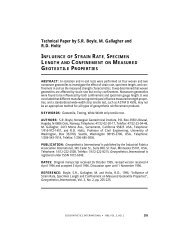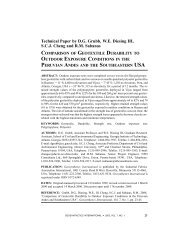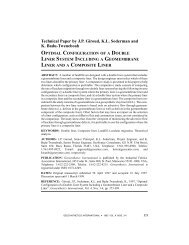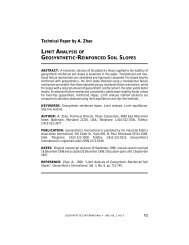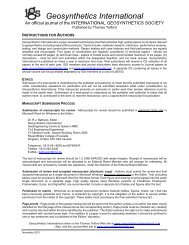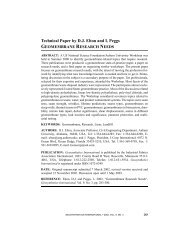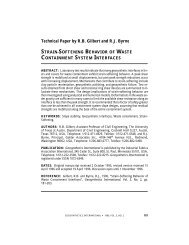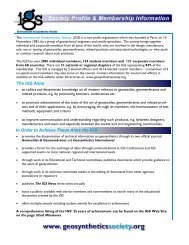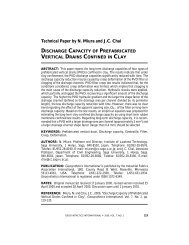Download Paper - IGS - International Geosynthetics Society
Download Paper - IGS - International Geosynthetics Society
Download Paper - IGS - International Geosynthetics Society
You also want an ePaper? Increase the reach of your titles
YUMPU automatically turns print PDFs into web optimized ePapers that Google loves.
Technical <strong>Paper</strong> by M.R. Madhav, N. Gurung and Y. Iwao<br />
ATHEORETICAL MODEL FOR THE PULL-OUT<br />
RESPONSE OF GEOSYNTHETIC REINFORCEMENT<br />
ABSTRACT: Soil-reinforcement pull-out tests are essential for evaluating the strength, integrity,<br />
and effectiveness of the soil-reinforcement system. In this paper, a new pull-out test<br />
model that calculates the soil-geosynthetic reinforcement interface shear stress for highly<br />
extensible geosynthetic reinforcement is proposed. Based on a new bilinear interface shear<br />
model, the geosynthetic pull-out test results are calculated with regard to the variation of the<br />
mobilised geosynthetic tension with distance, geosynthetic pre-yield and post-yield behaviour,<br />
and the effective and extended length of the geosynthetic reinforcement The resulting<br />
nonlinear equation for the soil-geosynthetic interface shear stress pull-out mechanism is<br />
nondimensionalised, expressed in a finite difference form, and solved numerically using the<br />
Gauss-Siedel technique. A parametric study is carried out for a range of relative stiffness values<br />
and interface shear stresses. The normalised load-displacement relationship and the<br />
variation of the pull-out force and reinforcement displacements, with distance along the reinforcement,<br />
are presented. The values calculated using the proposed model are compared<br />
with experimental pull-out test results for a needle-punched, nonwoven geotextile, polyester<br />
fibres coated with polyethylene, and nylon reinforcements.<br />
KEYWORDS: Analytical model, Finite difference method, Geosynthetic, Geotextile,<br />
Geomembrane, Numerical solution, Parametric study, Pull-Out test.<br />
AUTHORS: M.R. Madhav, Visiting Professor, Institute of Lowland Technology, Saga<br />
University, Saga 840, Japan and Professor of Civil Engineering, Indian Institute of<br />
Technology, Kanpur 208016, India, Telephone: 91/512-59-7144, Telefax:<br />
91/512-59-7395/0260/0007, E-mail: madhav@iitk.ernet.in; N. Gurung, Ph.D. Student, Civil<br />
Engineering, Saga University, Saga 840, Japan, Telephone: 81/952-28-8689, Telefax:<br />
81/952-28-8699, E-mail: 97ts53@edu.cc.saga-u.ac.jp; and Y. Iwao, Professor of Civil<br />
Engineering, Saga University, Saga 840, Japan, Telephone: 81/952-28-8687, Telefax:<br />
81/952-28-8699; E-mail: iwaoy@cc.saga-u.ac.jp.<br />
PUBLICATION: <strong>Geosynthetics</strong> <strong>International</strong> is published by the Industrial Fabrics<br />
Association <strong>International</strong>, 1801 County Road B West, Roseville, Minnesota 55113-4061,<br />
USA, Telephone: 1/612-222-2508, Telefax: 1/612-631-9334. <strong>Geosynthetics</strong> <strong>International</strong> is<br />
registered under ISSN 1072-6349.<br />
DATES: Original manuscript received 20 December 1997, revised version received 16<br />
March 1998 and accepted 21 March 1998. Discussion open until 1 March 1999.<br />
REFERENCE: Madhav, M.R., Gurung, N. and Iwao, Y., 1998, “A Theoretical Model for<br />
the Pull-Out Response of Geosynthetic Reinforcement”, <strong>Geosynthetics</strong> <strong>International</strong>, Vol.<br />
5, No. 4, pp. 399-424.<br />
GEOSYNTHETICS INTERNATIONAL S 1998, VOL. 5, NO. 4<br />
399
MADHAV, GURUNG AND IWAO D Theoretical Model for Pull-Out Response of <strong>Geosynthetics</strong><br />
1 INTRODUCTION<br />
The use of soil reinforcement to improve the strength and stability, and to mitigate<br />
total and differential settlements, of foundations and soil structures has become common<br />
practice in geotechnical engineering. Earth structures, such as airport pavements,<br />
embankments, landfills, earth slopes, and retaining walls are built with soil reinforcement<br />
for improved safety against sliding or bearing failure and to improve settlement<br />
response. <strong>Geosynthetics</strong> are now often used in weak or soft ground, reclaimed lowlands,<br />
and in geo-environmental engineering applications, e.g. landfills and reservoirs. The<br />
use of geosynthetics has unique advantages over other soil strengthening techniques,<br />
due to their low mass per unit area, strength, and stiffness characteristics. However, the<br />
use of geosynthetics requires a proper understanding of soil-geosynthetic interaction<br />
mechanisms. Field and laboratory pull-out tests are widely used to interpret soil-reinforcement<br />
interaction mechanisms. Yang (1972) and Schlosser and Long (1973) proposed<br />
anisotropic cohesion and enhanced confining pressure concepts, respectively, to<br />
explain the increased strength of reinforced soil. Hausmann (1976) reported the absence<br />
of anisotropic cohesion at low confining stresses, but postulated that reinforcement<br />
pull-out failure occurs by slippage or loss of soil-reinforcement interface shear<br />
stress. McGown et al. (1978) reported the different load-deformation responses (Figure<br />
1) for extensible and inextensible reinforcement materials. To understand the behaviour<br />
of geotextile-reinforced clays, various laboratory tests such as triaxial, direct shear,<br />
pull-out, and physical model tests were performed by Ingold (1981, 1983a, 1983b) and<br />
Ingold and Miller (1983). The basic design criteria for reinforced earth structures requires<br />
an analysis of the external and internal stability of the structure (Mitchell and<br />
Villet 1987; Christopher et al. 1989).<br />
Soil and inextensible reinforcement<br />
Soil and extensible reinforcement<br />
Axial load<br />
Unreinforced soil<br />
Axial strain<br />
Figure 1. Axial load-strain relationship for unreinforced soil and soil reinforced with<br />
extensible and inextensible reinforcement (McGown et al. 1978)<br />
400 GEOSYNTHETICS INTERNATIONAL S 1998, VOL. 5, NO. 4
MADHAV, GURUNG AND IWAO D Theoretical Model for Pull-Out Response of <strong>Geosynthetics</strong><br />
Jewell and Wroth (1987) established that reinforcement oriented in the direction of<br />
tensile strain strengthens the soil. Schlosser and de Buhan (1991) simplified the soil-reinforcement<br />
interaction mechanisms as either direct shear or pull-out by neglecting the<br />
bending resistance of the soil reinforcement. The pull-out resistance of geogrids was<br />
obtained in terms of friction and bearing components. Peterson and Anderson (1980)<br />
proposed a general bearing failure mechanism for welded wire mesh reinforcement,<br />
while Jewell et al. (1985) considered a punching shear failure mechanism for the passive<br />
bearing component of geogrid reinforcement. The two theories of general bearing<br />
and punching shear failure gave upper- and lower-bound estimates of the passive bearing<br />
contribution in pull-out test results (Palmeira and Milligan 1989; Jewell 1990). Jewell<br />
(1993) suggested the use of the critical state soil friction angle instead of the peak<br />
soil friction angle to calculate the bearing resistance for the case of extensible reinforcement,<br />
due to different degrees of bearing resistance mobilisation along the length<br />
of the reinforcement. Extensive pull-out tests have been reported by Berg and Swan<br />
(1991) (geogrid), Bergado et al. (1992, 1993, 1995) (steel grid) and Bergado and Chai<br />
(1994) (geogrid). Hayashi et al. (1994) conducted laboratory pull-out tests and measured<br />
the elongation at several points along the geosynthetic reinforcement. Inextensible<br />
steel grid reinforcement, as well as extensible geogrid reinforcement-soil systems<br />
were studied in detail by Alfaro (1996). Pradhan et al. (1997) investigated the effect of<br />
normal pressure during pull-out tests on a saturated clay-geosynthetic system. Based<br />
on field geosynthetic pull-out tests, Konami et al. (1997) proposed an elastic model for<br />
polymer strips. For the analysis of the pull-out behaviour of planar geosynthetic reinforcement,<br />
a model based on shear-lag theory was proposed by Abramento and Whittle<br />
(1995a). Segrestin and Bastick (1997) compared the pull-out capacity of extensible<br />
geosynthetic and inextensible steel grid reinforcement. A soil-geosynthetic reinforcement<br />
interface model based on rigid-plastic shear stress mobilisation has been reported<br />
by Sobhi and Wu (1996) for extensible reinforcement (geotextile). Long et al. (1997)<br />
used curve-fitting by parabolas to describe the nonuniform shear distribution at the<br />
soil-reinforcement interface.<br />
The model proposed in the current study considers highly extensible reinforcement,<br />
i.e. geosynthetics, and incorporates a bilinear shear stress-displacement relationship for<br />
the soil-reinforcement interface shear stress response during pull-out tests. Thus, the<br />
model considers prefailure deformations of the soil-reinforcement interface caused by<br />
shear stress. The nonlinear governing equation relating the applied pull-out force, displacement,<br />
and distance along the reinforcement from the applied pull-out force are<br />
normalised and solved numerically to obtain the pull-out force-displacement relationships<br />
and the variation of pull-out force and displacement of any point along the reinforcement.<br />
The numerical results of the current study are compared with the following<br />
published data: field and model pull-out test results on polyester fibres coated with<br />
polyethylene (Konami et al. 1997); laboratory and model pull-out test results using<br />
needle-punched, nonwoven geotextiles (Sobhi and Wu 1996); and laboratory pull-out<br />
test results for two nylon 6/6 sheet specimens (Abramento and Whittle 1995b).<br />
GEOSYNTHETICS INTERNATIONAL S 1998, VOL. 5, NO. 4<br />
401
MADHAV, GURUNG AND IWAO D Theoretical Model for Pull-Out Response of <strong>Geosynthetics</strong><br />
2 PULL-OUT MODEL<br />
2.1 Formulation of the Model<br />
Figure 2a is a schematic of a pull-out test on a geosynthetic sheet reinforcement of<br />
length, L, elastic modulus, E r , and thickness, t r . The tensile strength, T, of the reinforcement<br />
should be significantly high when compared to the pull-out force to prohibit reinforcement<br />
breakage. The pull-out force per unit width, T 0 , should be applied ormeasured<br />
slightly away from the face to avoid reinforcement end effects (Jewell and Wroth 1987).<br />
The applied pull-out force, T 0 , mobilises the soil-reinforcement interface shear stress,<br />
τ, acting along the reinforcement length (Figure 2b). The interface shear stress, τ, is<br />
governed by the interface shear stress response shown in Figure 2c (typical direct shear<br />
test results). The interface shear stress increases with displacement, w, and asymptotically<br />
reaches the maximum soil-reinforcement interface shear stress value, τ max .<br />
In the current study, the strain softening response that was observed in physical tests<br />
reported in the literature was not considered. For simplicity, the τ versus w curve was<br />
simplified using a bilinear response curve as follows:<br />
τ = k s1 w for 0 ≤ w ≤ w max<br />
(1)<br />
and<br />
τ = k s1 w max + k s2 (w − w max ) for w > w max<br />
(2)<br />
(a)<br />
T<br />
q s<br />
Soil (γ, φ)<br />
L<br />
Soil (γ, φ )<br />
(b)<br />
σ n =q s + γ D<br />
φ s/r<br />
D<br />
T 0<br />
Reinforcement (E r , t r )<br />
τ<br />
x<br />
(c)<br />
1<br />
k s2<br />
(d)<br />
T<br />
τ<br />
T + ΔT<br />
τ max<br />
w max w<br />
τ<br />
1<br />
k s1<br />
Δx<br />
τ<br />
Δw<br />
Δw = ε Δx<br />
Figure 2. Schematic of the forces acting on an extensible geosynthetic reinforcement layer<br />
during pull-out: (a) soil-reinforcement system; (b) forces acting on the reinforcement; (c)<br />
soil-reinforcement shear stress-displacement curve; (d) forces on a differential<br />
reinforcement segment, Δx, during pull-out.<br />
402 GEOSYNTHETICS INTERNATIONAL S 1998, VOL. 5, NO. 4
MADHAV, GURUNG AND IWAO D Theoretical Model for Pull-Out Response of <strong>Geosynthetics</strong><br />
where k s1 and k s2 equal the slope of the bilinear τ versus w curve in the pre- and post-yield<br />
ranges, respectively (Figure 2c), or the soil-reinforcement interface shear stiffnesses.<br />
The value of k s2 is typically equal to zero. However, for numerical simplicity, it was assumed<br />
to be 1/100 to 1/1000 the value of k s1 ,andw max = τ max / k s1 = displacement corresponding<br />
to the maximum interface shear stress.<br />
The maximum soil-reinforcement interface shear stress, τ max , is limited to:<br />
τ max = σ n tan φ s∕r = (q s + γ D) tanφ s∕r<br />
(3)<br />
where: σ n =(q s + γ D) = normal stress acting on the soil-reinforcement interface; q s =<br />
surcharge stress; γ = bulk unit weight of the fill; D = depth of the reinforcement; and<br />
tanφ s/r = soil-reinforcement interface friction angle.<br />
In the current study, the reinforcement was considered to be highly extensible as is<br />
the case for some geotextiles and geomembranes. Therefore, considering the extended<br />
length of a small differential element of length Δx and of unit width (Sobhi and Wu<br />
1996) (Figure 2d), the equilibrium of horizontal forces is satisfied by:<br />
(T + ΔT) − T + 2τ(Δx + Δw) = 0<br />
(4)<br />
where: T and (T + ΔT) = pull-out forces, i.e. tensile forces, in the reinforcement at the<br />
left and right ends; τ = mobilised soil-reinforcement interface shear stress; and Δw =<br />
elongation of the element.<br />
The elongation, Δw, is related to the strain, ε, by:<br />
Δw = ε Δx<br />
(5)<br />
while ε is related to the tensile force, T, by:<br />
ε = T ∕ E r t r<br />
(6)<br />
Equation 4 can be expressed as:<br />
dT<br />
+ 2 τ (1 + ε) = 0<br />
dx<br />
(7)<br />
Note that for the positive x-axis (to the right), ε =-dw/dx, Equations 6 and 7 can be<br />
combined to give:<br />
E r t<br />
d 2 w<br />
r + 2τ dw<br />
dx2 dx − 1 = 0<br />
Equation 8 is the basic equation governing the response of an extensible reinforcement.<br />
The interface shear stressgiven byEquations 1and 2are coupled with Equation 8 to give:<br />
(8)<br />
E r t r<br />
d 2 w<br />
dx 2 + 2k s1<br />
dw<br />
dx − 1 w = 0 for 0 ≤ w ≤ w max<br />
E r t r<br />
d 2 w<br />
dx 2 + 2[k s1 w max + k s2 (w − w max )] dw<br />
dx − 1 = 0 for w > w max<br />
(9)<br />
(10)<br />
GEOSYNTHETICS INTERNATIONAL S 1998, VOL. 5, NO. 4<br />
403
MADHAV, GURUNG AND IWAO D Theoretical Model for Pull-Out Response of <strong>Geosynthetics</strong><br />
The boundary conditions are:<br />
at x = 0, T = T 0 or ε = T 0<br />
E r t r<br />
=− dw<br />
dx<br />
at x = L, T = 0 or ε = 0<br />
(11)<br />
(12)<br />
If k s1 = ∞ and k s2 = 0, Equation 10 reduces to the simple and elegant expression reported<br />
by Sobhi and Wu (1996). Equations 9 and 10 can be nondimensionalised and<br />
simplified to:<br />
d 2 W<br />
+ α β dW<br />
dX2 dX<br />
− 1 W = 0 for 0 ≤ W ≤ 1<br />
(13)<br />
and<br />
d 2 W<br />
dX + α [1 + R 2 k (W − 1)] β dW − 1 = 0 for W > 1<br />
dX<br />
(14)<br />
where: W = w / w max ; X = x / L; R k = k s2 / k s1 = stiffness ratio; and:<br />
α = 2 k s1 L 2<br />
and β = w max<br />
E r t r L<br />
or<br />
τ max<br />
k s1 L<br />
where: α = normalised interface stiffness (or relative stiffness parameter); and β = relative<br />
displacement parameter.<br />
The boundary conditions in nondimensional form become:<br />
ε =− dw<br />
dx = T 0<br />
E r t r<br />
or<br />
dW<br />
dX =−α T* at X = 0 (15)<br />
ε = dW<br />
dX = 0 at X = 1 (16)<br />
where: T * = T 0 / T max ;andT max =2τ max L = maximum pull-out force.<br />
2.2 Numerical Solution<br />
Equations 13 and 14 are nonlinear differential equations that cannot be solved analytically.<br />
Discretising the reinforcement into n elements each of length ∆L = L/n or ∆X =<br />
1/n (Figure 3), and expressing the derivatives in a finite difference form, Equations 13<br />
and 14 can be rewritten for the i th node as:<br />
W i−1 −2W i +W i+1<br />
+ αβ W i+1−W i−1<br />
−1W<br />
(ΔX) 2<br />
i = 0 for 0 ≤ W i ≤ 1 (17)<br />
2ΔX<br />
and<br />
404 GEOSYNTHETICS INTERNATIONAL S 1998, VOL. 5, NO. 4
MADHAV, GURUNG AND IWAO D Theoretical Model for Pull-Out Response of <strong>Geosynthetics</strong><br />
W i−1 −2W i +W i+1<br />
+ αβ W i+1+W i−1<br />
−1 [1 + R<br />
(ΔX) 2<br />
k (W i −1)] = 0 for W i > 1<br />
2ΔX<br />
The normalised displacement at node n = i, W i , is obtained iteratively from:<br />
(18)<br />
W i = W i−1 + W i+1<br />
if W i < 1.0<br />
2 − α C 1 ∕ n 2<br />
W i = W i−1 + W i+1 + α (1 − R k ) C 1 ∕ n 2<br />
2 − α C 1 R k ∕ n 2 if W i > 1.0<br />
where<br />
(19)<br />
(20)<br />
C 1 = β n W i+1 − W i−1<br />
− 1<br />
2<br />
To solve for displacements at nodes i =1andi = n + 1, two fictitious nodes i =2i to<br />
the left of node i =1andi = n + 2 to the right of node i = n + 1 were assumed. The displacements<br />
at these nodes can easily be derived from the boundary conditions (Equations<br />
15 and 16) as:<br />
W 2′ = W 2 + (2 α T)∕n<br />
(21)<br />
W n = W n+2<br />
Knowing W 2i and W n+2 , the normalised displacements at node i =1andi = n +1are<br />
once again obtained from Equations 19 and 20. From the known displacements along<br />
the reinforcement length, the strain, ε i , and normalised pull-out force, T i , at node i,are<br />
calculated as follows:<br />
ε i = n W i−1 − W i+1<br />
2<br />
<br />
T i = n W i−1 − W i+1<br />
2α<br />
<br />
(22)<br />
(23)<br />
(24)<br />
2.3 Estimation of the Parameter α<br />
The first approximate value of α may be estimated by neglecting the term βdW/dX<br />
→ 0 at the lower pull-out force, but the value of α at a higher pull-out force may slightly<br />
X =0 X =1<br />
n =<br />
2i<br />
1 2<br />
i --- 1 i i +1 n n +1 n +2<br />
Figure 3. Discretisation of the geosynthetic reinforcement that is used in the current study<br />
to model reinforcement pull-out.<br />
GEOSYNTHETICS INTERNATIONAL S 1998, VOL. 5, NO. 4<br />
405
MADHAV, GURUNG AND IWAO D Theoretical Model for Pull-Out Response of <strong>Geosynthetics</strong><br />
change as per the slope value k s1 in the τ versus w response. For the initial estimation,<br />
Equation 13 can be approximated as:<br />
d 2 W<br />
dX − α W = 0 for 0 ≤ W ≤ 1<br />
2<br />
The closed form solution of Equation 25 is:<br />
W = A′ cosh α<br />
X + B′ sinh α<br />
X for 0 ≤ W ≤ 1<br />
(25)<br />
(26)<br />
Differentiating Equation 26 gives:<br />
dW<br />
dX =<br />
A′ sinh α<br />
α<br />
X + B′ cosh α<br />
X<br />
Solving for the following boundary conditions (Equations 15 and 16), i.e.:<br />
− dW<br />
dX = α T* and B′ =−α<br />
T<br />
*<br />
at X = 0<br />
− dW = 0<br />
dX<br />
and A′ =−B′ cothα<br />
at X = 1<br />
The solution is:<br />
W = α<br />
T<br />
*<br />
cothα<br />
(27)<br />
cosh α<br />
X − sinh α<br />
X for 0 ≤ W ≤ 1 (28)<br />
Equation 28 may be redefined as:<br />
<br />
W = w∕w max = α T<br />
T maxcoth<br />
<br />
α<br />
cosh α<br />
X − sinh α<br />
X<br />
or<br />
At the pull-out end, i.e. at X =0:<br />
w ⎧ α T<br />
w =<br />
max<br />
⎪<br />
w<br />
T = w max<br />
2 k s1 w max L ⎪ ⎧ ⎩<br />
T<br />
⎩ max<br />
⎪ ⎫ ⎭ coth<br />
α<br />
tanh<br />
⎪⎫ ⎭ =<br />
α<br />
α<br />
L<br />
α<br />
Er t r tanh<br />
<br />
α<br />
(29)<br />
(30)<br />
Equation 30 is an expression for the initial slope of the displacement versus pull-out<br />
force in terms of the reinforcement characteristics, E r , t r ,andL, and the interface shear<br />
stiffness, k s1 . Typically, E r , t r ,andL are known; therefore, k s1 can easily be estimated<br />
from the initial slope of the pull-out force-displacement curve. Equation 30 can be nondimensionalised<br />
to give:<br />
wE r t r<br />
LT = 1<br />
<br />
(31)<br />
α tanh = f (α)<br />
α<br />
406 GEOSYNTHETICS INTERNATIONAL S 1998, VOL. 5, NO. 4
MADHAV, GURUNG AND IWAO D Theoretical Model for Pull-Out Response of <strong>Geosynthetics</strong><br />
1.6<br />
f (α), α -1/2<br />
1.2<br />
0.8<br />
0.4<br />
α -1/2<br />
f (α)<br />
0<br />
1 10 100<br />
Normalised stiffness parameter, α<br />
Figure 4. Plot of α -1/2 and f(α) versus α.<br />
Equation 31 is proposed to estimate the initial values of α from the pull-out force-displacement<br />
test results. The variation of the function in Equation 31 with α is shown in<br />
Figure 4, and can be used to estimate the value of α and, subsequently, the value of k s1 .<br />
However, the value of k s1 estimated from the initial portion of the τ versus w curve corresponds<br />
to the initial tangent value of the interface shear stiffness. If a more accurate value<br />
of k s1 , covering a larger range of stresses, is required, it is preferable to estimate the<br />
secant value of k s1 from the latter portion of the τ versus w curve (e.g. T 0.3 T max ). For<br />
large values of α, the function f(α) is almost equal to α -1/2 .<br />
3 RESULTS AND DISCUSSION<br />
The solutions for the normalised displacements, strains, and normalised pull-out<br />
forces along the reinforcement length are obtained by solving Equations 19 to 24 numerically.<br />
The accuracy of the solution is verified by varying n: the number of elements<br />
into which the reinforcement is discretised. The difference in the displacement values<br />
for n = 20 and 40 was negligible; therefore, n = 20 was adopted for all further calculations.<br />
Parametric studies were performed for the following ranges of parameters: T * =<br />
0to1.0,α = 2 to 200, and β = 0.00001 to 0.2. The product αβ =(T max / E r t r )=(2σ n tanφ s/r<br />
L) /( E r t r ) is a function of the maximum pull-out force and the reinforcement stiffness<br />
only and is independent of the unit shear stiffness, k s1 . The test results reported by Sobhi<br />
and Wu (1996) were derived from the above formulation with a finite value of αβ but<br />
with either α → 0orβ → 0andR k = 0. The normalised pull-out force versus normalised<br />
displacement relationship for α =50andβ = 0.01 was obtained for different values of<br />
R k (0.01, 0.001, and 0.0001). For any given value of αβ , the values of R k 0.001 did<br />
not affect the resulting solution in terms of the normalised pull-out force versus normalised<br />
displacement response (Figure 5); therefore, a value of R k = 0.001 was used in the<br />
current parametric study.<br />
GEOSYNTHETICS INTERNATIONAL S 1998, VOL. 5, NO. 4<br />
407
MADHAV, GURUNG AND IWAO D Theoretical Model for Pull-Out Response of <strong>Geosynthetics</strong><br />
Normalised pull-out force, T*<br />
1.0<br />
0.8<br />
0.6<br />
0.4<br />
0.2<br />
0.0<br />
R k = 0.0001<br />
R k = 0.001<br />
R k =0.01<br />
α = 50, β =0.01<br />
0 5 10 15<br />
Normalised displacement of the pull-out end, W 0<br />
Figure 5. Effect of R k on the pull-out force versus the normalised displacement for α =50<br />
and β = 0.01.<br />
Normalised pull-out force, T*<br />
1.0<br />
0.8<br />
0.6<br />
0.4<br />
0.2<br />
0.0<br />
2<br />
5<br />
10<br />
20<br />
100<br />
0 10 20<br />
Normalised displacement of the pull-out end, W 0<br />
50<br />
α = 200<br />
β =0.01<br />
Figure 6. Normalised pull-out force versus the normalised displacement for β =0.01and<br />
different α values.<br />
The variation of the normalised displacement, W 0 , at the pull-out end (X = 0) with<br />
the normalised pull-out force, T * , is presented in Figure 6, for β = 0.01 and for different<br />
values of the relative stiffness parameter, α. The displacements increase linearly with<br />
the pull-out force for values of T * < 0.5. The rate of increase in W 0 is greater at higher<br />
pull-out forces because the elements near the pull-out force end attain the maximum<br />
interface shear stress values and slip without mobilising any additional interface shear<br />
stress. Theoretically, as T * → 1.0, the displacement, W 0 , should approach infinity but<br />
is finite because of the nonzero values of R k that correspond to the ratios of slopes of<br />
408 GEOSYNTHETICS INTERNATIONAL S 1998, VOL. 5, NO. 4
MADHAV, GURUNG AND IWAO D Theoretical Model for Pull-Out Response of <strong>Geosynthetics</strong><br />
the bilinear unit interface shear stress relationship in the post- and pre-peak regions. The<br />
normalised displacements at any given pull-out force, T * , increase with increasing values<br />
of α. For a given soil-reinforcement interface, values of α increase either if the<br />
length of the reinforcement, L, is larger, or if the stiffness of the reinforcement, E r ,is<br />
smaller. In either case, it was expected that the displacements at all pull-out force levels<br />
would increase with increasing α values because of the increased specimen length, or<br />
because the reinforcement is highly extensible. The normalised displacements at T * =<br />
0.6 for β = 0.01 are 0.946, 1.427, 2.249, 3.830, 7.995, 13.390, and 20.750 for α =2,5,<br />
10, 20, 50, 100, and 200, respectively. Results, similar to those shown in Figure 6, are<br />
obtained for β = 0.1 (Figure 7). For the case of β = 0.1, the normalised displacements<br />
at the pull-out end, W 0 , are smaller because β = 0.1 implies that there is a higher maximum<br />
interface shear stress, τ max . The normalised displacements at T * =0.6forβ =0.1<br />
are 0.913, 1.280, 1.800, 2.534, 3.590, 3.880, and 4.180, for α = 2, 5, 10, 20, 50, 100,<br />
and 200, respectively.<br />
The influence of the relative displacement parameter, β, on the normalised pull-out<br />
end displacement versus the normalised pull-out force response is shown in Figure 8<br />
for α = 5. By varying the β value (0.2, 0.1, 0.05, 0.01, and 0.001) and maintaining a<br />
constant α value, it is implied that the maximum interface shear stress, τ max , varies, but<br />
the interface shear stiffness, k s1 , is constant. As the β value increases, greater maximum<br />
pull-out forces, T max , and greater maximum displacement values, w max , are required to<br />
reach the yield or maximum interface shear stress. Consequently, the curves for greater<br />
β values have an extended linear portion and exhibit relatively smaller pull-out end displacements<br />
for all pull-out force values. For example, at T * = 0.5, the displacements are<br />
0.987, 1.102, and 1.153 for β = 0.2, 0.05, and 0.001, respectively. The differences in<br />
the displacement values increase with increasing pull-out force. The results are not affected<br />
by the value of β for β 0.001.<br />
1.0<br />
Normalised pull-out force, T*<br />
0.8<br />
0.6<br />
0.4<br />
0.2<br />
0.0<br />
2 5<br />
0 2 4<br />
Normalised displacement of the pull-out end, W 0<br />
10<br />
20<br />
50<br />
100<br />
α = 200<br />
β =0.01<br />
Figure 7. Normalised pull-out force versus the normalised displacement for β = 0.1 and<br />
different α values.<br />
GEOSYNTHETICS INTERNATIONAL S 1998, VOL. 5, NO. 4<br />
409
MADHAV, GURUNG AND IWAO D Theoretical Model for Pull-Out Response of <strong>Geosynthetics</strong><br />
Normalised pull-out force, T*<br />
1.0<br />
0.8<br />
0.6<br />
0.4<br />
0.2<br />
0.0<br />
β =0.2<br />
β =0.1<br />
β =0.0<br />
β = 0.001<br />
β =0.01<br />
α =5<br />
0 1 2 3<br />
Normalised displacement of the pull-out end, W 0<br />
Figure 8. Normalised pull-out force versus the normalised displacement for α =5.<br />
Normalised pull-out force, T*<br />
1.0<br />
0.8<br />
0.6<br />
0.4<br />
0.2<br />
0.0<br />
α =5, β =0.02<br />
α =2, β =0.05<br />
α = 10, β =0.01<br />
αβ=0.1<br />
0 1 2 3<br />
Normalised displacement of the pull-out end, W 0<br />
Figure 9.<br />
Normalised pull-out force versus the normalised displacement for αβ=0.1.<br />
The displacement response for different values of α (10, 5, and 2) and β (0.01, 0.02,<br />
and 0.05), but for a constant αβ value of 0.1, and different pull-out forces is shown in<br />
Figure 9. A significant decrease in the displacement at any given pull-out force occurs<br />
with decreasing α values. The displacement values are very sensitive to the value of β.<br />
Low β values ( (w max / L)=(τ max / k s1 L)) imply a low shear stress, significantly long reinforcement,<br />
or a significantly high interface stiffness response (i.e. high k s1 value); thus,<br />
the response curves are highly nonlinear for low values of β. Therefore, Figure 9 shows<br />
the importance of considering both the stiffness and the maximum shear stress of the<br />
interface. Displacement dampening may be the assumed mechanism causing a reduc-<br />
410 GEOSYNTHETICS INTERNATIONAL S 1998, VOL. 5, NO. 4
MADHAV, GURUNG AND IWAO D Theoretical Model for Pull-Out Response of <strong>Geosynthetics</strong><br />
tion in α values. Also, higher β values indicate a reduced stiffness of the interface response.<br />
The variation of displacement with distance along the length of the<br />
reinforcement for various pull-out force values is shown in Figure 10 for a constant value<br />
of αβ = 1, but with different values of α and β: α =50andβ = 0.02; and α =5and<br />
β = 0.2. The displacements are rapidly dampened with increasing normalised distance<br />
values for higher α and lower β values, which implies that only a part of the reinforcement<br />
actively mobilises the pull-out resistance. In contrast, if α is smaller or β is larger,<br />
the full length of the reinforcement participates in mobilising pull-out resistance. These<br />
results emphasise the need to consider the interface stiffness parameter k s1 .<br />
The importance of considering the interface stiffness is realised by considering the<br />
normalised pull-out force versus the normalised distance along the length of the reinforcement<br />
for αβ products comprising different values of α and β. The curves for the<br />
two pairs of α and β values (α =5,β =0.1andα = 50, β = 0.01), but with the same<br />
product αβ = 0.5, demonstrate the effect of k s1 or α on the pull-out interaction (Figure<br />
11). The stiffer the reinforcement, the shorter the length of resistance at all stress levels.<br />
From Figure 11, the extended length of the reinforcement can be determined for a given<br />
applied pull-out force. For any given maximum interface shear stress, τ max ,andreinforcement<br />
characteristics (E r , t r ,andL), the product αβ is unique. However, it can be<br />
concluded that the interface shear stiffness, k s1 , has a significant influence on the pullout<br />
response for highly extensible reinforcement. The normalised pull-out force versus<br />
the normalised distance along the length of the reinforcement curves are highly nonlinear,<br />
particularly for higher relative stiffness parameter values, α .<br />
Normalised displacement, W<br />
10<br />
α = 50, β =0.02<br />
α =5, β =0.2<br />
T* = 0.95<br />
0.6<br />
0.2<br />
αβ=1<br />
0<br />
0.0 0.2 0.4 0.6 0.8 1.0<br />
Normalised distance along the reinforcement, X = x / L<br />
Figure 10. Displacement versus the normalised distance along the length of the<br />
reinforcement for αβ=1.<br />
GEOSYNTHETICS INTERNATIONAL S 1998, VOL. 5, NO. 4<br />
411
MADHAV, GURUNG AND IWAO D Theoretical Model for Pull-Out Response of <strong>Geosynthetics</strong><br />
Normalised pull-out force, T *<br />
1.0<br />
0.8<br />
0.6<br />
0.4<br />
0.2<br />
0.0<br />
α = 50, β =0.01<br />
α =5, β =0.1<br />
αβ=0.5<br />
0.0 0.2 0.4 0.6 0.8 1.0<br />
Normalised distance along the reinforcement, X = x / L<br />
Figure 11. Pull-out force versus the normalised distance along the length of the<br />
reinforcement for αβ=0.5.<br />
4 VALIDATION OF THE PROPOSED MODEL<br />
4.1 Konami et al. (1997)<br />
Konami et al. (1997) report results from field pull-out tests on three types of polymer<br />
strip reinforcements, PW-3, PW-5, and PW-10, that were 85, 90, and 95 mm wide and<br />
2, 3, and 5 mm thick, respectively. The polymer was made of polyester fibres coated with<br />
polyethylene. The reinforcement strips were tested at various depths in a fill compacted<br />
to a unit weight of 20.6 kN/m 3 and 18.6 kN/m 3 to represent natural and dry conditions,<br />
respectively. The reinforcement lengths were 3.5 and 5.5 m. The parameter E r t r =3.43<br />
× 10 3 ,5.39× 10 3 , and 1.02 × 10 3 kN/m at 2% strain, and 2.30 × 10 3 ,3.92× 10 3 ,<br />
and 8.71 × 10 3 kN/m at 5% strain, for PW-3, PW-5, and PW-10, respectively. The interface<br />
friction angle, φ s/r , between the fill and the reinforcement was 38.2 _ based on direct<br />
shear tests. The maximum pull-out stress could not exceed the mobilised maximum interface<br />
shear stress or the breaking strength of the material itself (which ever is less).<br />
From the published data, using the concept of mobilised friction varying with the mean<br />
stress level (Jewell and Wroth 1987) or depth (Bolton and Powerie 1988), the value of<br />
the mobilised interface coefficient of friction versus normal stress was plotted (Figure<br />
12). At approximately 14% elongation, the reinforcement broke due to the tensile stress.<br />
From the data reported by Konami et al. (1997), the normal stress, σ n , maximum interface<br />
shear stress, τ max = σ n φ s/r , and maximum pull-out force, T max =2τ avg L for various<br />
depths were calculated and are summarised in Table 1. The values of the interface shear<br />
stiffness, k s1 , were not available; therefore, these values were estimated using Equation<br />
31 or Figure 4 by the method presented in Section 2.3. Knowing the value of the product<br />
αβ and estimating the value of α, the value of β was calculated. The estimated k s1 value,<br />
the adopted E r t r value, and the calculated values of α and β are given in Table 2.<br />
412 GEOSYNTHETICS INTERNATIONAL S 1998, VOL. 5, NO. 4
MADHAV, GURUNG AND IWAO D Theoretical Model for Pull-Out Response of <strong>Geosynthetics</strong><br />
Coefficient of friction, μ s/r<br />
1.4<br />
0.7<br />
0.0<br />
0 20 40 60 80 100<br />
Normal stress (kN/m 2 )<br />
Figure 12. Soil-reinforcement interface coefficient of friction versus normal stress (data<br />
interpreted from Konami et al. 1997).<br />
Table 1. Pull-out test parameters interpreted from the data reported by Konami et al. (1997).<br />
Test number<br />
D<br />
(m)<br />
σ n<br />
(kN/m 2 )<br />
Estimated μ s/r<br />
(_)<br />
τ max<br />
(kN/m 2 )<br />
L<br />
(m)<br />
T max<br />
(kN/m)<br />
1 4.8 86.4 0.30 25.92 3.5 181.440<br />
2 3.2 57.6 0.44 25.34 3.5 177.408<br />
3 1.6 28.8 0.45 12.96 3.5 90.720<br />
4 0.8 14.4 0.80 11.52 3.5 80.640<br />
6 4.0 72.0 0.36 25.92 5.5 285.120<br />
7 2.4 43.2 0.33 14.26 5.5 156.816<br />
8 0.8 14.4 0.80 11.52 5.5 126.720<br />
Notes: D = depth of reinforcement; σ n = normal stress; μ s/r = interface coefficient of friction; τ max =maximum<br />
interface shear stress; L = length of reinforcement; and T max = maximum pull-out force.<br />
Table 2. Estimated pull-out test parameters adopted in the current study for comparison<br />
with the data reported by Konami et al. (1997).<br />
Test number<br />
D<br />
(m)<br />
Specimen<br />
number<br />
E r t r<br />
(kN/m)<br />
αβ= T max / E r t r<br />
Estimated k s1<br />
(kN/m 3 )<br />
1 4.8 PW-5 59.7 0.030 272.9 1.12 0.027136<br />
2 3.2 PW-5 59.7 0.030 443.5 1.82 0.016328<br />
3 1.6 PW-3 38.8 0.023 483.0 3.05 0.007666<br />
4 0.8 PW-3 38.8 0.021 245.5 1.55 0.013409<br />
6 4.0 PW-10 102 0.028 413.1 2.45 0.011409<br />
7 2.4 PW-5 59.7 0.026 483.5 4.90 0.005361<br />
8 0.8 PW-3 38.8 0.033 246.9 3.85 0.008483<br />
Notes: D = depth of reinforcement; E r = Young’s modulus of reinforcement; t r = thickness of reinforcement;<br />
α = relative stiffness parameter; β = relative displacement parameter; T max = maximum pull-out force; and k s1<br />
= initial slope of shear stress-displacement curve in Figure 2c = soil-reinforcement interface shear stiffness.<br />
α<br />
β<br />
GEOSYNTHETICS INTERNATIONAL S 1998, VOL. 5, NO. 4<br />
413
MADHAV, GURUNG AND IWAO D Theoretical Model for Pull-Out Response of <strong>Geosynthetics</strong><br />
The estimated value of k s1 corresponds to the initial tangent value of the shear-stress<br />
versus displacement curves for the pull-out tests. By choosing appropriate combinations<br />
of α and β, it is possible to predict the pull-out force versus displacement relations.<br />
For a comparative illustration, upper- and lower-bound responses for different α and<br />
β values, but for the same αβ value, are compared with the predicted and field test results<br />
reported by Konami et al. (1997). The first approximate values of α and β, based<br />
on the lower pull-out force, were estimated (Table 2). At higher pull-out forces, the α<br />
and β values may change as the slope, k s1 , of the stress-displacement response changes.<br />
The second refined values of α and β in Figures 13 (1.12 and 0.0181, respectively) and<br />
14 (1.82 and 0.0163, respectively) predicted displacement values that are closer to the<br />
field test results reported by Konami et al. (1997). The calculated displacement was underpredicted<br />
for α and β values that were based on the initial tangent value of k s1 , while<br />
the calculated displacement based on an appropriate choice of α and β values appears<br />
to closely fit the field test results (Figures 13 to 19).<br />
Figures 13 to 16 compare the field test results with the predicted, or calculated results<br />
(based on a simple approach assuming mobilisation of the full interface shear stress<br />
over an effective reinforcement length), and the model proposed in the current study.<br />
The Konami et al. (1997) predicted results for field tests Nos. 6, 7, and 8 were not available<br />
(Figures 17, 18, and 19). The deviations present in Figures 17, 18, and 19 could<br />
be minimised by choosing a smooth τ versus w curve instead of a bilinear curve.<br />
4.2 Sobhi and Wu (1996)<br />
Pull-out test results for 300 mm long and 3.18 mm thick needle-punched, nonwoven<br />
geotextile specimens (Sobhi and Wu 1996) are compared with the results of the model<br />
proposed in the current study (Figures 20 to 23). For a normal stress of 40 kPa, the<br />
maximum pull-out force was 6.96 kN/m assuming μ s/r = 0.29. Using a geotextile stiff-<br />
Pull-out force, T (kN/m) 0 (kN/m)<br />
1.8<br />
1.6<br />
1.4<br />
1.2<br />
1.0<br />
0.8<br />
0.6<br />
0.4<br />
0.2<br />
0.0<br />
Predicted (Konami et al. 1997)<br />
Field test No. 1 (Konami et al. 1997)<br />
Proposed model, α = 1.12, β = 0.0271 (Table 2)<br />
Proposed model, α = 1.12, β = 0.0181<br />
0 40 4 808 120 160<br />
Displacement (mm)<br />
Figure 13. Comparison of the predicted reinforcement pull-out displacements with the<br />
pull-out test data (predicted and field test No. 1) reported by Konami et al. (1997).<br />
414 GEOSYNTHETICS INTERNATIONAL S 1998, VOL. 5, NO. 4
MADHAV, GURUNG AND IWAO D Theoretical Model for Pull-Out Response of <strong>Geosynthetics</strong><br />
Pull-out force (kN/m)<br />
180 1.8<br />
160 1.6<br />
140 1.4<br />
120 1.2<br />
100 1.0<br />
0.8 80<br />
0.6 60<br />
0.4 40<br />
0.2 20<br />
Predicted (Konami et al. 1997)<br />
Field test No. 2 (Konami et al. 1997)<br />
Proposed model, α = 1.12, β = 0.0163 (Table 2)<br />
Proposed model, α = 1.12, β = 0.0074<br />
0.00<br />
0 40 4 80 8 120 160<br />
Displacement (mm)<br />
Figure 14. Comparison of the predicted reinforcement pull-out displacements with the<br />
pull-out test data (predicted and field test No. 2) reported by Konami et al. (1997).<br />
Pull-out force (kN/m)<br />
0.9 90<br />
0.8 80<br />
0.7 70<br />
0.6 60<br />
0.5 50<br />
0.4 40<br />
0.3 30<br />
0.2 20<br />
0.1 10<br />
Predicted (Konami et al. 1997)<br />
Field test No. 3 (Konami et al. 1997)<br />
Proposed model, α = 3.05, β = 0.0077 (Table 2)<br />
0.00<br />
0 50 5 100<br />
Displacement (mm)<br />
Figure 15. Comparison of the predicted reinforcement pull-out displacements with the<br />
pull-out test data (predicted and field test No. 3) reported by Konami et al. (1997).<br />
ness E r t r = 31.8 kN/m, the product αβ was estimated to be 0.212. Table 3 summarises<br />
the known and estimated parameter values. The estimated values of α and β using a<br />
low pull-out force were 25.0 and 0.0087 in the first test, respectively, and α =7.00and<br />
β = 0.0031 in the second test, which is closer to the results reported by Sobhi and Wu<br />
(1996). The response at higher pull-out forces may be improved by refining the values<br />
of α and β from the initial slope, k s1 ,oftheτ - w curve. Deviations in the values calcu-<br />
GEOSYNTHETICS INTERNATIONAL S 1998, VOL. 5, NO. 4<br />
415
MADHAV, GURUNG AND IWAO D Theoretical Model for Pull-Out Response of <strong>Geosynthetics</strong><br />
Pull-out force (kN/m)<br />
140 1.4<br />
120 1.2<br />
100 1.0<br />
0.8 80<br />
0.6 60<br />
0.4 40<br />
0.2 20<br />
Predicted (Konami et al. 1997)<br />
Field test No. 4 (Konami et al. 1997)<br />
Proposed model, α = 1.55, β = 0.0134 (Table 2)<br />
0.00<br />
0 50<br />
5<br />
100<br />
10<br />
150<br />
15<br />
200<br />
20<br />
Displacement (mm)<br />
Figure 16. Comparison of the predicted reinforcement pull-out displacements with the<br />
pull-out test data (predicted and field test No. 4) reported by Konami et al. (1997).<br />
Pull-out force (kN/m)<br />
280 2.8<br />
240 2.4<br />
160 2.0<br />
200 1.6<br />
120 1.2<br />
0.8 80<br />
0.4 40<br />
Field test No. 6 (Konami et al. 1997)<br />
Proposed model, α = 2.45, β = 0.0114 (Table 2)<br />
0.00<br />
0 50 5 100 150 200<br />
Displacement (mm)<br />
Figure 17. Comparison of the predicted reinforcement pull-out displacements with the<br />
pull-out test data (predicted and field test No. 6) reported by Konami et al. (1997).<br />
lated using the proposed model may be reduced by adopting different values of α and<br />
β as per the real slope, k s1 ,oftheτ - w curve. Sobhi and Wu (1996) obtained closedform<br />
solutions for the pull-out force assuming full shear resistance mobilisation and a<br />
rigid, plastic response.<br />
416 GEOSYNTHETICS INTERNATIONAL S 1998, VOL. 5, NO. 4
MADHAV, GURUNG AND IWAO D Theoretical Model for Pull-Out Response of <strong>Geosynthetics</strong><br />
1.6 160<br />
Pull-out force (kN/m)<br />
1.2 120<br />
0.8 80<br />
0.4 40<br />
Field test No. 7 (Konami et al. 1997)<br />
Proposed model, α = 4.90, β = 0.0054 (Table 2)<br />
0.00<br />
0 50 100 150 200<br />
Displacement (mm)<br />
Figure 18. Comparison of the predicted reinforcement pull-out displacements with the<br />
pull-out field test data (field test No. 6) reported by Konami et al. (1997).<br />
120 1.2<br />
Pull-out force (kN/m)<br />
0.8 80<br />
0.4 40<br />
Field test No. 8 (Konami et al. 1997)<br />
Proposed model, α = 3.85, β = 0.0085 (Table 2)<br />
0.00<br />
0 50 5 100 150 200<br />
Displacement (mm)<br />
Figure 19. Comparison of the predicted reinforcement pull-out displacements with the<br />
pull-out field test data (field test No. 8) reported by Konami et al. (1997).<br />
Table 3. Pull-out test parameters adopted for comparison with results reported by Sobhi<br />
and Wu (1997).<br />
σ n<br />
(kPa)<br />
μ s/r<br />
(_)<br />
E r t r<br />
(kN/m)<br />
L<br />
(mm)<br />
αβ= T max /E r t r<br />
Estimated, k s1<br />
(kN/m 3 )<br />
40 0.29 31.8 300 0.218868 1237 7 0.0031<br />
40 0.29 31.8 300 0.218868 4417 25 0.0087<br />
α<br />
β<br />
GEOSYNTHETICS INTERNATIONAL S 1998, VOL. 5, NO. 4<br />
417
MADHAV, GURUNG AND IWAO D Theoretical Model for Pull-Out Response of <strong>Geosynthetics</strong><br />
5<br />
Pull-out force (kN/m)<br />
Pull-out force (kN/m)<br />
4<br />
3<br />
2<br />
1<br />
0<br />
Experimental, x = 0 mm (Sobhi and Wu 1996)<br />
Predicted (Sobhi and Wu 1996)<br />
Proposed model, α = 7.00, β = 0.0031 (Table 3)<br />
Proposed model, α = 25.0, β = 0.0087 (Table 3)<br />
0 10 20 30<br />
Displacement (mm)<br />
Figure 20. Comparison of the predicted reinforcement pull-out displacements with the<br />
pull-out test data (laboratory and predicted) reported by Sobhi and Wu (1996) at the applied<br />
pull-out force end of the reinforcement, x =0.<br />
5<br />
Pull-out force (kN/m)<br />
4<br />
3<br />
2<br />
1<br />
0<br />
Experimental, x = 75 mm (Sobhi and Wu 1996)<br />
Predicted (Sobhi and Wu 1996)<br />
Proposed model, α = 7.00, β = 0.0031 (Table 3)<br />
Proposed model, α = 25.0, β = 0.0087 (Table 3)<br />
0 5 10 15 20<br />
Displacement (mm)<br />
Figure 21. Comparison of the predicted reinforcement pull-out displacements with the<br />
pull-out test data (laboratory and predicted) reported by Sobhi and Wu (1996) at the applied<br />
pull-out force end of the reinforcement, x = 75 mm.<br />
4.3 Abramento and Whittle (1995b)<br />
Laboratory pull-out tests on nylon 6/6 sheet specimens reported by Abramento and<br />
Whittle (1995b) were analysed using the model proposed in the current study. The characteristic<br />
length, width, and thickness of the test specimens, designated as ASPR 57 and<br />
59, were 420.0, 133.4, and 0.508 mm, respectively. The tests were conducted at a confining<br />
pressure, σ 1 = 24.5 kPa, and at displacement rates of 35 and 3.5 μm/s. The sand-<br />
418 GEOSYNTHETICS INTERNATIONAL S 1998, VOL. 5, NO. 4
MADHAV, GURUNG AND IWAO D Theoretical Model for Pull-Out Response of <strong>Geosynthetics</strong><br />
5<br />
Pull-out force (kN/m)<br />
Pull-out force (kN/m)<br />
4<br />
3<br />
2<br />
1<br />
0<br />
Experimental, x = 150 mm (Sobhi and Wu 1996)<br />
Predicted (Sobhi and Wu 1996)<br />
Proposed model, α = 7.00, β = 0.0031 (Table 3)<br />
Proposed model, α = 25.0, β = 0.0087 (Table 3)<br />
0 4 8 12<br />
Displacement (mm)<br />
Figure 22. Comparison of the predicted reinforcement pull-out displacements with the<br />
pull-out test data (laboratory and predicted) reported by Sobhi and Wu (1996) at the applied<br />
pull-out force end of the reinforcement, x = 150 mm.<br />
5<br />
Pull-out<br />
Pull-out<br />
force<br />
force<br />
(kN/m)<br />
(kN/m)<br />
4<br />
3<br />
2<br />
1<br />
0<br />
Experimental, x = 175 mm (Sobhi and Wu 1996)<br />
Predicted (Sobhi and Wu 1996)<br />
Proposed model, α = 7.00, β = 0.0031 (Table 3)<br />
Proposed model, α = 25.0, β = 0.0087 (Table 3)<br />
0 2 4 6 8 10<br />
Displacement (mm)<br />
Figure 23. Comparison of the predicted reinforcement pull-out displacements with the<br />
pull-out test data (laboratory and predicted) reported by Sobhi and Wu (1996) at the applied<br />
pull-out force end of the reinforcement, x = 175 mm.<br />
nylon interface friction angle values varied from φ s/r =20to25 _ . The estimated value<br />
of T max =2L σ 1 tanφ s/r = 9.596 kN/m resulted in the product αβ = T max / E r t r = 0.0084.<br />
The laboratory pull-out test results for specimens ASPR 57 and 59 are plotted and<br />
compared to the proposed model pull-out test results for α =3.25andβ = 0.00258, and<br />
α =1.39andβ = 0.00604 (Figure 24). Table 4 summarises the adopted parameters.<br />
Thus, it may be concluded that the proposed model reasonably predicts the laboratory<br />
test results. The information on k s1 , α,andβ can improve the accuracy of pull-out forcedisplacement<br />
prediction.<br />
GEOSYNTHETICS INTERNATIONAL S 1998, VOL. 5, NO. 4<br />
419
MADHAV, GURUNG AND IWAO D Theoretical Model for Pull-Out Response of <strong>Geosynthetics</strong><br />
1.2<br />
Pull-out force (kN)<br />
1.0<br />
0.8<br />
0.6<br />
0.4<br />
0.2<br />
0.0<br />
ASPR 59 (Abramento and Whittle 1995b)<br />
Proposed model, α = 3.25, β = 0.00258 (Table 4)<br />
ASPR 57 (Abramento and Whittle 1995b)<br />
Proposed model, α = 1.39, β = 0.00604 (Table 4)<br />
0 1 2 3 4<br />
Displacement at reinforcement pull-out end (mm)<br />
Figure 24. Comparison of the predicted pull-out displacements with the measured<br />
laboratory pull-out test displacements reported by Abramento and Whittle (1995b) for<br />
nylon 6/6 sheet specimens (ASPR 59 and 57).<br />
Table 4.<br />
(1995).<br />
Pull-out test parameters adopted for comparison with Abramento and Whittle<br />
Nylon6<br />
ASPR<br />
σ n<br />
(kPa)<br />
μ s/r<br />
(_)<br />
E r t r<br />
(kN/m)<br />
L<br />
(mm)<br />
αβ= T max / E r t r<br />
Estimated, k s1<br />
(kN/m 3 )<br />
57 24.5 20 to 25_ 975.36 420 0.0084 8985 3.25 0.00258<br />
59 24.5 20 to 25_ 975.36 420 0.0084 3843 1.39 0.00604<br />
α<br />
β<br />
5 CONCLUSIONS<br />
A new model for pull-out of highly extensible reinforcement has been proposed. The<br />
resulting nonlinear governing equation was nondimensionalised in order to perform a<br />
parametric analysis. The nondimensionalised equation was expressed in a finite difference<br />
form and solved using the Gauss-Siedel iteration method. The accuracy of the numerical<br />
solution was checked by varying the number of elements. The results showed<br />
that the discretisation of the reinforcement length into 20 elements gives accurate values<br />
within a reasonable amount of computational time.<br />
Two new nondimensional interaction terms, the relative stiffness parameter, α, and<br />
the relative displacement parameter, β, for soil-reinforcement interaction were<br />
introduced. A bilinear form of the soil-geosynthetic interface shear stress mobilisation<br />
with displacement was taken into consideration. A method for estimating the first<br />
approximate value of the normalised soil-reinforcement interface stiffness, or relative<br />
stiffness parameter, α , based on α values within the low pull-out force-displacement<br />
range is presented. A refinement of the stiffness parameter at higher pull-out loads requires<br />
the value of k s1 , which may be deduced from the slope of the τ - w curve. Normal-<br />
420 GEOSYNTHETICS INTERNATIONAL S 1998, VOL. 5, NO. 4
MADHAV, GURUNG AND IWAO D Theoretical Model for Pull-Out Response of <strong>Geosynthetics</strong><br />
ised pull-out force versus displacement responses are presented for various ranges of<br />
relative stiffness parameters α and β . The predicted displacements are compared with<br />
the following field and laboratory pull-out test results: field pull-out tests on polymer<br />
strips (Konami et. al 1997), laboratory pull-out tests on geotextile specimens (Sobhi and<br />
Wu 1997, and laboratory pull-out tests on nylon 6/6 sheet specimens (Abramento and<br />
Whittle 1995b). The model presented in the current paper gives fair predictions of the<br />
pull-out behaviour of extensible reinforcement. A better estimation of the soil-reinforcement<br />
interaction parameters such as τ, μ s/r , k s1 , α,andβ could improve the predictability<br />
of the test results even further. The effective length of the reinforcement can be<br />
easily predicted from the pull-out force versus displacement plots; thus, obviating the<br />
need to estimate the effective length of the reinforcement by using simplifying assumptions.<br />
REFERENCES<br />
Abramento, M. and Whittle, J.A., 1995a, “Analysis of Pullout Tests for Planar Reinforcements<br />
in Soil”, Journal of Geotechnical Engineering, Vol. 121, No. 6, pp.<br />
476-485.<br />
Abramento, M. and Whittle, J.A., 1995b, “Experimental Evaluation of Pullout Analyses<br />
for Planar Reinforcements”, Journal of Geotechnical Engineering, Vol. 121, No.<br />
6, pp. 486-492.<br />
Alfaro, M.C., 1996, “Reinforced Soil Wall-Embankment System on Soft Foundation using<br />
Inextensible and Extensible Grid Reinforcements”, Ph.D Thesis, Saga University,<br />
Saga, Japan, 225 p.<br />
Berg, R.R. and Swan, R.H., 1991, “Investigation into Geogrid Pullout Mechanism”,<br />
Performance of Reinforced Soil Structures, McGown, A., Yeo, K., and Andrawes,<br />
K.Z., Editors, Thomas Telford, 1991, Proceedings of the <strong>International</strong> Reinforced<br />
Soil Conference held in Glasgow, Scotland, September 1990, pp. 353-357.<br />
Bergado, D.T., Lo, K.H., Chai, J.C., Alfaro, M.C. and Anderson, L.R., 1992, “Pullout<br />
Tests using Steel Grid Reinforcement with Low-quality Backfill”, Journal of Geotechnical<br />
Engineering, Vol. 118, No. 7, pp. 1047-1063.<br />
Bergado, D.T., Macatol, K.C., Amin, N.U., Chai, J.C. and Alfaro, M.C., 1993, “Interaction<br />
of Lateritic Soil and Steel Grid Reinforcement”, Canadian Geotechnical Journal,<br />
Vol. 30, No. 2, pp. 376-384.<br />
Bergado, D.T. and Chai, J.C., 1994, “Pullout Force-Displacement Relationship of Extensible<br />
Grid Reinforcements”, Geotextile and Geomembranes, Vol. 13, No. 5, pp.<br />
295-316.<br />
Bergado, D.T., Miura, N. and Alfaro, M.C., 1995, “Evaluations of Inextensible and Extensible<br />
Grid Reinforcements in Infrastructure Projects on Soft Bangkok Clay” Research<br />
of Lowland Technology No.4, March 1995, ILT, Saga University, Saga, Japan,<br />
pp. 102-112.<br />
Bolton, M.D., and Powerie, W., 1988, “Behaviour of Diaphragm Walls in Clay prior<br />
to Collapse”, Geotechnique, Vol. 38, No. 2, pp. 167-189.<br />
GEOSYNTHETICS INTERNATIONAL S 1998, VOL. 5, NO. 4<br />
421
MADHAV, GURUNG AND IWAO D Theoretical Model for Pull-Out Response of <strong>Geosynthetics</strong><br />
Christopher, B.R., Gill, S.A., Giroud, J.P., Juran, I., Schlosser F., Mitchell, J.K. and<br />
Dunnicliff, J., 1989, “Reinforced Soil Structures: Volume I. Design and Construction<br />
Guidelines”, Report No. FHWA-RD-89-043, Washington, DC, USA, November<br />
1989, 287 p.<br />
Hausmann, M.R., 1976, “Strength of Reinforced Soil”, Proceedings of the Eight Australian<br />
Road Research Conference, Vol. 8, Section 13, pp. 1-8.<br />
Hayashi, S., Makiuchi, K., Ochiai, H., Fukuoka, M. and Hirai, T., 1994, “Testing Methods<br />
for Soil-Geosynthetic Friction at Geosynthetic Interfaces”, Proceedings of the<br />
Fifth <strong>International</strong> Conference on Geotextiles, Geomembranes and Related Products,<br />
Vol. 1, Singapore, September 1994, pp. 411-414<br />
Ingold, T.S., 1981, “A Laboratory Simulation of Clay Walls”, Geotechnique, Vol. 31,<br />
No. 3, pp. 399-412.<br />
Ingold, T.S., 1983a, “Reinforced Clay Subjected to Undrained Triaxial Loading”, Journal<br />
of Geotechnical Engineering, Vol. 109, No. 5, pp. 738-744.<br />
Ingold, T.S., 1983b, “A Laboratory Investigation of Grid Reinforcement in Clay”,<br />
ASTM Geotechnical Testing Journal, Vol. 6, No. 3, pp. 112-119<br />
Ingold, T.S. and Miller, K.S., 1983, “Drained Axisymmetric Loading of Reinforced<br />
Clay”, Journal of Geotechnical Engineering, Vol. 109, No. 7, pp. 883-898.<br />
Jewell, R.A., Milligan G.W.E., Sarsby, R.W. and DuBois, D., 1985, “Interaction Between<br />
Reinforcement and Geogrids”, Polymer Grid Reinforcement, Thomas Telford,<br />
1985, Proceedings of a conference held in London, UK, March 1984, pp. 18-30.<br />
Jewell, R.A., and Wroth, C.P., 1987, “Direct Shear Tests on Reinforced Sand”, Geotechnique,<br />
Vol. 37, No. 1, pp. 53-68.<br />
Jewell, R.A., 1990, “Reinforcement Bond Capacity”, Geotechnique, Vol. 40, No. 3, pp.<br />
513-518.<br />
Jewell, R.A., 1993, “Links Between the Testing, Modelling and Design of Reinforced<br />
Soil”, Keynote Lecture, Earth Reinforcement Practice, Ochiai, H., Hayashi, S. and<br />
Otani, J., Editors, Balkema, 1993, Proceedings of the <strong>International</strong> Symposium on<br />
Earth Reinforcement Practice, Vol. 2, Kyushu University, Fukuoka, Japan, November<br />
1992, pp. 755-772.<br />
Konami, T., Imaizumi, S. and Takahashi, S., 1997, “Elastic Considerations of Field<br />
Pull-out Tests of Polymer Strip”, Earth Reinforcement, Ochiai, H., Yaufuku, N. and<br />
Omine, K., Editors, Balkema, 1997, Proceedings of the <strong>International</strong> Symposium on<br />
Earth Reinforcement, Vol. 1, Fukuoka, Kyushu, Japan, November 1996, pp. 57-62.<br />
Long, P.V., Bergado, D.T. and Balasubramanian, A.S., 1997 “Interaction Between Soil<br />
and Geotextile Reinforcement”, Ground Improvement, Ground Reinforcement and<br />
Ground Treatment: Developments 1987-1997, Schaefer, V.R., Editor, ASCE Geotechnical<br />
Special Publication No. 69, proceedings of the symposium held in Logan,<br />
Utah, USA, July 1997, pp. 560-578.<br />
McGown, A., Andrawes, K.Z. and Al-Hasani, M.M., 1978, “Effect of Inclusion Properties<br />
on the Behaviour of Sand”, Geotechnique, Vol. 28, No. 3, pp. 327-346.<br />
422 GEOSYNTHETICS INTERNATIONAL S 1998, VOL. 5, NO. 4
MADHAV, GURUNG AND IWAO D Theoretical Model for Pull-Out Response of <strong>Geosynthetics</strong><br />
Mitchell, J.K. and Villet, W.C.B., 1987, “Reinforcement of Slopes and Embankments”,<br />
National Cooperative Highway Research Program Report No. 290, Transportation<br />
Research Board, National Research Council, Washington, DC, USA, 323 p.<br />
Palmeira, E.M. and Milligan, G.W.E., 1989, “Scale and Other Factors Affecting the Results<br />
of Pullout Tests of Grids Buried in Sand”, Geotechnique, Vol. 39, No. 3, pp.<br />
511-524.<br />
Peterson, L.M. and Anderson, L.R., 1980, “Pullout Resistance of Welded Wire Mats<br />
Embedded in Soil”, Research Report submitted to Hilfiker Company, Department of<br />
Civil and Environmental Engineering, Utah State University, Utah, USA, 106 p.<br />
Pradhan, T.B.S., Shiwakoti, D.R. and Imai, G., 1997, “Effect of Normal Pressure and<br />
Width of Geosynthetic Horizontal Drain in Pullout Behaviour using Saturated Clay”,<br />
Earth Reinforcement, Ochiai, H., Yaufuku, N. and Omine, K., Editors, Balkema,<br />
1997, Proceedings of the <strong>International</strong> Symposium on Earth Reinforcement, Vol. 1,<br />
Fukuoka, Kyushu, Japan, November 1996, pp. 133-138.<br />
Schlosser, F. and Long, N.T., 1973, “Recent Results in French Research on Reinforced<br />
Soil”, Journal of Construction Engineering, Vol. 100, No. 3, pp. 223-237.<br />
Schlosser, F. and de Buhan, P., 1991, “Theory and Design Related to the Performance<br />
of Reinforced Soil Walls”, Performance of Reinforced Soil Structures, McGown, A.,<br />
Yeo, K., and Andrawes, K.Z., Editors, Thomas Telford, 1991, Proceedings of the <strong>International</strong><br />
Reinforced Soil Conference held in Glasgow, Scotland, September 1990,<br />
pp. 1-14.<br />
Segrestin, P. and Bastick, M., 1997, “Comparative Study and Measurement of the Pullout<br />
Capacity of Extensible and In-extensible Reinforcements”, Earth Reinforcement,<br />
Ochiai, H., Yaufuku, N. and Omine, K., Editors, Balkema, 1997, Proceedings of the<br />
<strong>International</strong> Symposium on Earth Reinforcement, Vol. 1, Fukuoka, Kyushu, Japan,<br />
November 1996, pp. 139-144.<br />
Sobhi, S. and Wu, J.T.H., 1996, “Interface Pullout Formula for Extensible Sheet Reinforcement”,<br />
<strong>Geosynthetics</strong> <strong>International</strong>, Vol. 3, No. 5, pp. 565-581.<br />
Tzong, W.H. and Cheng-Kuang, S., 1987, “Soil-Geotextile Interaction Mechanism in<br />
Pull-out Test”, Proceedings of <strong>Geosynthetics</strong> ’87, IFAI, Vol. 1, New Orleans, Louisiana,<br />
USA, February 1987, pp. 250-259.<br />
Yang, Z.Z., 1972, “Strength and Deformation Characteristics of Reinforced Sand”,<br />
Ph.D Thesis, University of California, Los Angeles, California, USA.<br />
NOTATIONS<br />
Basic SI units are given in parentheses.<br />
D = depth of reinforcement (m)<br />
E r = Young’s modulus of reinforcement (Pa)<br />
i = node number (dimensionless)<br />
k s1 = initial slope of shear stress-displacement curve in Figure 2c<br />
= soil-reinforcement interface shear stiffness (N/m 3 )<br />
GEOSYNTHETICS INTERNATIONAL S 1998, VOL. 5, NO. 4<br />
423
MADHAV, GURUNG AND IWAO D Theoretical Model for Pull-Out Response of <strong>Geosynthetics</strong><br />
k s2 = post-yield slope of shear stress-displacement curve in Figure 2c<br />
= soil-reinforcement interface shear stiffness (N/m 3 )<br />
L = length of reinforcement (m)<br />
n = number of discretisation elements (dimensionless)<br />
q s = surcharge stress (Pa)<br />
R k = k s2 / k s1 = stiffness ratio (dimensionless)<br />
W = w / w max = normalised displacement of reinforcement (dimensionless)<br />
W 0 = normalised displacement of reinforcement pull-out end (dimensionless)<br />
W i = normalised displacement of i th element (dimensionless)<br />
w = displacement of reinforcement (m)<br />
w max = τ / k s1 = displacement of reinforcement at yield, i.e. at maximum interface<br />
shear stress (m)<br />
t r = thickness of reinforcement (m)<br />
T = tensile force at any point, x, along reinforcement (N/m)<br />
T max = maximum pull-out force in reinforcement (N/m)<br />
T 0 = reinforcement pull-out force per unit width (N/m)<br />
T * = T / T max = normalised tensile force in reinforcement (dimensionless)<br />
X = x / L = normalised co-ordinate along length of reinforcement<br />
(dimensionless)<br />
x = co-ordinate along length of reinforcement (m)<br />
α = normalised soil-reinforcement interface stiffness, or relative stiffness<br />
parameter (dimensionless)<br />
β = relative displacement parameter (dimensionless)<br />
ε = axial strain (dimensionless)<br />
γ = soil bulk unit weight (N/m 3 )<br />
μ s/r = tanφ s/r = soil-reinforcement interface coefficient of friction<br />
(dimensionless)<br />
σ n = normal stress (Pa)<br />
τ = soil-reinforcement interface shear stress (Pa)<br />
τ avg = average soil-reinforcement interface shear stress value (Pa)<br />
τ max = limiting or maximum soil-reinforcement interface shear stress (Pa)<br />
φ = soil friction angle (_)<br />
φ s/r = soil-reinforcement interface friction angle (_)<br />
424 GEOSYNTHETICS INTERNATIONAL S 1998, VOL. 5, NO. 4



